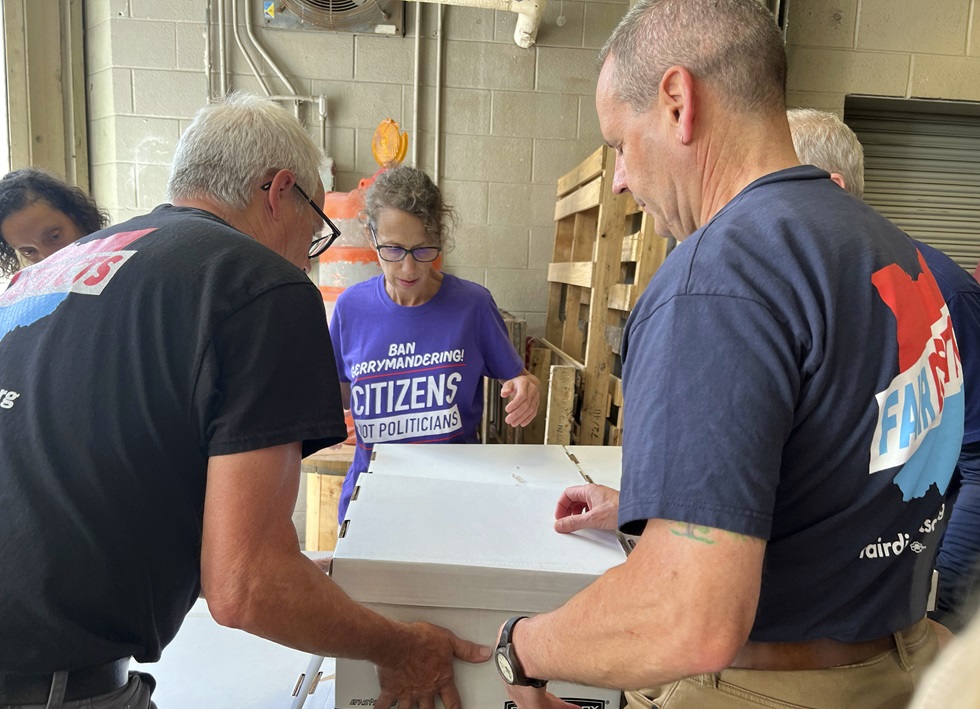
COLUMBUS—Ohio is one of the most gerrymandered states in the country, with Congressional district lines carving up the state in ways that guarantee right-wing political domination in election after election. Many people in Ohio are tired of it, but Republicans in the state are doing everything they can to keep things exactly as they are.
Issue 1, also known as the “Citizens Not Politicians Initiative,” is a proposed amendment to the Ohio State Constitution that’s up for a statewide vote this November. It proposes the creation of a citizen-led redistricting commission which will draw new state legislative districts and congressional districts.
The proposed amendment is a citizen-led ballot initiative, the result of a grassroots effort that collected the thousands of signatures necessary to bring the issue to a vote.
Despite broad support in pre-election polling, Ohio Issue 1 has become the target of conservative attacks. Republican politicians, like Sec. of State Frank LaRose, intentionally introduced misleading ballot language for the issue, printing directly on the ballot that the measure would “create an appointed redistricting commission not elected by or subject to removal by the voters of the state.”
The ballot description approved by LaRose also deceptively claims that Issue 1 is pro-gerrymandering because it would appeal earlier redistricting laws.
Groups like the right-wing Ohio Works, meanwhile, allege that the proposed amendment will create an expensive, unaccountable redistricting bureaucracy, and cement gerrymandering into Ohio’s constitution – despite, again, that being the very thing the measure seeks to reverse.
On the other hand, civil rights groups, labor organizations, and a number of politicians from both sides of the aisle have expressed support for Issue 1, with one national redistricting expert calling it “the closest to a silver bullet” that there is when it comes “to getting fair districting.”
So, what is Issue 1 actually advocating, and how does it compare to the current way district lines are drawn in Ohio?
The language of the proposed amendment goes to great lengths to create a fair, transparent, and accountable redistricting committee composed of citizens with no connections to the current political apparatus.
Specifically, the initiative:
- Ensures the equal representation of Republicans, Democrats, and independents on future redistricting commissions.
- Works to ensure the demographic composition of the commission reflects that of the state.
- Bars current or recent former politicians, lobbyists, political staffers, or family members of these groups from participating on the commission.
- Outlines a detailed process of redistricting for the commission to follow, including the incorporation of specific criteria to consider while drawing districts.
- Implements a fair, ranked-choice voting system in the event of an impasse within the commission.
- Delineates specific per diem compensation rates for commission members and the retired judges who will help select them, only allowing flexibility in the budget for legal fees and the hiring of non-partisan experts to assist the commission with gathering, interpreting, and presenting data throughout the redistricting process.
- Mandates periods for public comment and reconsideration of district maps based on public input, as well as legal procedures which would enable members of the public to challenge maps they deem unfair or non-representative.
The current system of redistricting came as the result of previous ballot initiatives passed in 2015 and 2018. Those measures created and refined a redistricting commission composed of current party politicians from both the Democratic and Republican parties, albeit not in equal proportions. The current redistricting commission is supposed to require bipartisan support for any proposed redistricting maps, but its rules include a caveat that enables a majority vote to determine the approval of short-term redistricting maps if bipartisan support cannot be obtained.

This system has resulted in Ohio being one of the top ten most gerrymandered states in the country, according to the World Population Review. Given the vast financial interests influencing state politicians, it is not surprising that the current district map has served to institutionalize and over-represent the minority capitalist class and its interests. These interests actively hurt working people and contribute to the political marginalization of under-represented groups.
For example, the League of Women Voters of Ohio and the ACLU have expressed concerns about Ohio’s 5th, 6th, 7th, 8th, and 15th districts, highlighting the cultural, economic, and demographic inconsistencies encompassed in these large districts and the splitting of communities of color.
From culturally distinct areas of voters being merged together throughout the historically underrepresented Appalachian region of Ohio to already marginalized communities of color in the city of Massillon being split in half, the current process of redistricting dilutes and divides the political influence of working people.
States that have implemented citizen-led redistricting commissions, such as Colorado and Michigan, have improved the fairness of their redistricting maps and have given their citizens a more direct voice in state politics.
Ultimately, Issue 1 allows Ohioans to directly choose the policy they want for their state going forward. In a state where heavy gerrymandering and massive spending by special interests have resulted in the implementation of wildly unpopular policies, Ohioans have a historic opportunity to forge a new path by drawing their own voting districts.
As with all op-eds and news-analysis articles published by People’s World, this article reflects the views of its author.
We hope you appreciated this article. At People’s World, we believe news and information should be free and accessible to all, but we need your help. Our journalism is free of corporate influence and paywalls because we are totally reader-supported. Only you, our readers and supporters, make this possible. If you enjoy reading People’s World and the stories we bring you, please support our work by donating or becoming a monthly sustainer today. Thank you!










